Peeking at their transcripts, students observed the effects of Drake University’s first semester under the recently implemented plus/minus grading system.
The average GPA of Drake student in 2016 fell from 3.25 in the spring to 3.22 in the fall, according to statistics compiled by the Office of Student Records.
Drake University switched from the traditional system of whole-letter grades in August last year. However, the power of the plus/minus implementation lay on the instructors of each course. Individual departments and schools, for consistency and equity, responded according to the needs of their students.
Responses from faculty and students were positive and negative.
“I’m really not happy with my A- grade, because my score was 91 percent, supposedly an A,” senior Chu Jie Siaw said. “It did affect my GPA. But I think it’s a good thing for a student if they really want to motivate themselves to study and put more effort in the class.”
Preferred name policy ready for implementation
can really feel alienated or feel really uncomfortable correcting their name in front of the class,” Rainbow Union President Ann Radtke said.
Students will soon be able to change the first name that appears on a number of Drake platforms, from their email address to their student ID card.
The student preferred name policy is expected to be implemented in the coming weeks, says DIrector of Student Engagement, Equity and Inclusion Tony Tyler. The policy has been a long time coming.
“When I came here (over five years ago), it was already being discussed as a theme that should be happening,” Tyler said. “There have been discussions here about it for years.”
The new policy, which ended its public review period last week, will allow all students to submit the first name they would like to appear on non-legal documents and other platforms.
This includes ID cards, residence hall rosters, Blackboard, MyDUSIS, class and advisor lists and email addresses.
While any student can take advantage of it, the policy takes a step to make Drake more inclusive for students in the LGBT community, more specifically transgender students.
“When you hear that name you were given at birth, a lot of people
“My name feels neutral enough that I don’t feel the need to change it,” said Paxton Gillespie, One Voice President.
Gillespie is a transgender woman, identifying as a woman but assigned a male identity at birth. “But for a lot of people (for example) who identify as men but have traditionally feminine birth names, by someone calling you by that birth name, it can have all of the gendered stereotypes about that name attached to you. You’re not being seen for who you are and how you identify, which… causes a lot of anxiety.”
Radkte said that for those being called by their legal name instead of the name they now identify with, it can lead to a lack of understanding and inclusion in the classroom. The student preferred name policy avoids this by showing teachers only the preferred name on the roster.
“(A legal name is) very alienating because it’s everywhere,” Radkte said. “Do people really accept you for who you are?”
Difference in gender identity and names can lead to gender dysphoria for some transgender people.
“For me, dysphoria is the feeling that you’re not being
perceived in the way that you want to be perceived,” Gillespie said. “I wanted to be perceived as a woman, and a lot of times people don’t perceive me as a woman or don’t treat me the way they would treat a woman. So that causes a lot of anxiety within me because I know I’m a woman. When someone says this name that has a gender that you don’t identify with at all... it brings all that pain back up.”
Tyler said the idea of a preferred name policy floated around campus even before he began working at the university. However, the project really started moving forward after the 2014 campus pride index assessment, a national assessment tool administered by the national organization Campus Pride. The index gauged LGBT inclusion on college campuses.
Drake received two stars out of five for LGBT inclusion. Tyler then met with students to address how to move forward to improve. About a year ago, a working group came together with members from IT and student records to finally make the student preferred name a reality.
“(We) said okay, let’s do this,” Tyler said. “Let’s really do this. What would it take to make this happen? We’ve been working on this really diligently since last January through the spring semester.”
Tyler presented the policy
drafts and ideas to members of Drake’s LGBT support group Rainbow Union and LGBT advocacy group One Voice for feedback and improvement.
“There were a lot of people who were excited,” Radtke said. “I even had people who aren’t LGBT involved (say) they were excited for it to because it can be easier for them as well.”
The final, reassuring push for the project came in May of last year. A “dear colleague” letter arrived at Drake from the U.S. Departments of Justice and Education. The letter clarified that trasngender students fall under Title IX protection.
“Essentially the Title IX policy outlines all the ways in which schools must protect trans students,” Gillepsie said. “If those guidelines are violated, it would be a violation of Title IX, just as if a sexual assault case were mishandled or if the school were discriminating against disabled or other marginalized groups.”
Drake’s Title IX coordinator Katie Overberg explained that lacking a student preferred name policy did not put Drake in danger of violating Title IX.
Iowa code already includes transgender people under the Civil Rights Act of 1965. Drake’s own nondiscrimination statement already includes students of all gender identities.
Search continues for associate provost for equity and inclusion
A committee of several students and staff has narrowed down the internal application pool to these two candidates.
This week, several interviews with the finalists for the first Associate Provost for Equity and Inclusion will take place. Two sessions allow Drake students to attend and provide feedback on the candidates.
“Anyone can come to that at all. They’ll do a short 20 minute presentation and the rest of the time will be question and answer from the audience,” said Tony Tyler, the director of student engagement, equity and inclusion in student life.
Darcie Vandegrift was interviewed on Tuesday. At 4 p.m. on Thursday, Feb. 2 it will be Erin Lain’s turn in Sussman Theater.
The candidates are then subjected to a full day of interviews with various strategic groups and the provost, Sue Mattison, as well as the special session open to students at 4 p.m.
Tyler said that the open interviews have been planned to get the campus’ input on each candidate.
At each interview session, students will be able to give feedback by filling out an online survey. The surveys will be open over the weekend and closed for review on Monday.
That data will then be used to make a recommendation to the provost.
“I think these will be two hours that students could invest
in something that will have an immediate effect on them both in curricular and co-curricular ways,” said Jill Allen, a member of the committee and Assistant Professor of Psychology. “If they were to come to one or both of these sessions, they could expect, in the first part of the session, to really hear the candidate’s mission, top priorities and goals.”
Many members of the committee stressed how important they believe this position is to the Drake campus.
“(This associate provost could) really be, in some regard, the point person who is able to know exactly which group, which resource on campus, which office to help to coordinate some of these efforts because right now we have individual level and interpersonal change,” Allen said.
“If we really want institutional
change, long lasting policy change, we need someone in a position where that’s what they’re focused on.”
As Allen mentioned, another popular reason for supporting the position so strongly was the current lack of an administrative level position whose job is to promote institutional level change.

“Right now on Drake’s campus, everyone who is working to make it more diverse and... more inclusive are doing it outside of their (primary) job,” said sophomore Deshauna Carter, another member of the committee and the student equity and inclusion senator. “I think that giving this to someone whose sole purpose on Drake’s campus is to work towards that will make it go so much faster than people like Tony Tyler or Jennifer
Harvey who are doing these things outside of what they are already supposed to be doing.”
Several committee members said that they were looking for members of the Drake community who were already making change on campus so that they could start work immediately. Carter had a few ideas as to what kinds of projects the new associate provost position could deal with.
“I definitely would hope that one thing they would do is start making a scholarship fund for marginalized identities because a lot of other universities do offer that and Drake doesn’t,” Carter said. “Having them work towards that would be amazing. I think that working towards Drake’s curriculum having more classes in it that will help students learn about marginalized identities.”
twitter: @timesdelphic | instagram: @draketimesdelphic | facebook: Times-Delphic
Katherine Bauer News Editor katherine.bauer@drake.edu @bauer_katherine Plus/minus: minus for students
Drake Rhone Staff Writer drake.rhone@drake.edu @drakerhone
CONTINUED ON PAGE 3
page 3
2 CAMPUS NEWS ADMINISTRATIVE NEWS ADMINISTRATIVE NEWS Lórien MacEnulty Staff Writer lorien.macenulty@drake.edu @lorienmacenulty [ ]td timesdelphic.com
TWENTY-FIVE students spent their J-Term in Washington D.C. learning about what a career in the nation’s capital would look like. A part of their trip was seeing the inauguration of President Donald Trump. Read more
on
CONTINUED ON PAGE
Wednesday, Feb. 01, 2017
PHOTO COURTESY OF GRACE DUNN
Women’s March brings message to Des Moines, attracts students
Elise Bauernfeind Contributing Writer elise.bauernfeind@drake.edu @elisej29
On Jan. 21, over 600 women’s marches took place across all across the world to promote and bring attention to women’s rights. At the march held in Des Moines, over 26,000 people attended, with several Drake students among them.

Sophomore Claire Franksen said she decided to attend because the march stood for many things she is passionate about.
“It’s not about being antiTrump,” Franksen said. “It’s about supporting women.”
She said it was important to her that the day was not about one issue, or issues at all, but instead a celebration of women and women’s rights. She wanted all women to feel comfortable attending regardless of their stances on individual issues.
“I felt that, as a white woman, it’s my responsibility to use my privilege for the better good,” Franksen said.
Senior Hannah Bovard also attended the march in hopes of using her privilege for good.
“I really wanted to show my solidarity and support of all different groups of women, whether that’s trans women, native women, women of color, women with disabilities or anyone else who doesn’t feel as supported or represented,” Bovard said.
attendance.
“The front steps of the Capitol were packed, all the way down to the street where the Capitol lawn meets East Village,” Dietz said.
“Before we marched, there was an announcement that the march had completely circled the capitol. There were so many people that we could not all fit on the streets around the Capitol, so we had to wait our turn to march.”
All three women said that they felt a strong sense of community at the march.
“It felt like this entire community was coming together,” Franksen said. “Then, looking at all the marches worldwide and realizing that so many people were doing the same things and standing up for the same things, I just constantly wanted to cry tears of joy and happiness, but also kind of sad that we have to march.”
Bovard said she felt the strongest sense of community when marchers left the sidewalks and flooded the streets.
“It was like this huge traffic jam, but it moved really fast,” Bovard said. “It was just really empowering to see how many people came out there.”
Dietz said she was not only inspired by the amount of people who attended, but the diversity of those in attendance.
“It was incredibly inspiring to be surrounded by people of all ages, genders, races, classes and feeling similar feelings,” Dietz said.
had to do with children. Dietz said she loved seeing children marching with signs that they had made themselves.
“A little boy held up a sign that was as big as him that said, ‘Trump is drama for my mama,’” Dietz said. “It was so sad that these children will have to grow up in a Trump presidency, but so amazing that they have parents that would bring them to marches and would tell them that this is not okay.”

Bovard was also inspired by the children who were in attendance, but also by the elderly women who came out and marched.
“There was such a big age diversity there,” Bovard said. “It was really powerful because there were really old women who were there, but there were also babies who couldn’t even talk, and it was just all these people showing up (that) was so awesome.
For Franksen, the most powerful experience was participating in a collective moment of silence as she was leaving.
PROTESTERS of all ages were on the steps of the Iowa Capitol the day after the inauguration to make their voices heard.
Senior Elena Dietz said she felt overwhelmed and empowered by the sheer number of people in
Dietz and Bovard both said that the most profound and powerful moments of their days
“We took part in this moment of silence, which was really powerful,” Franksen said. “Everyone had their heads bowed, and I kind of looked up and I looked around and actually took in what was happening. It was like all of these people were here for the same thing. It was like a pure moment of silence when we could have been yelling, but we were all silent in solidarity. It was just a moment to just think and appreciate this day. It was insane.”
New policy offers privacy for students of the transgender community
CONTINUED FROM PAGE 1
Before the student preferred name policy, Drake was accommodating students who sought out a name change on a case-by-case basis.
The new policy, Overberg explained, simply makes the name-change an easy, recognized option for students.
“I do know multiple people who would benefit from this,” Radtke said. “I know that, even though if I don’t know them, I know there are other people on campus who would take advantage of this,
even if it is to explore their gender identity.”
Tyler said that 1,300 students currently have a different preferred name in the system from when they came to Drake. Of those, 900 preferred names are “significantly different” from the legal name.
Tyler said that this is not an indication of all transgender students who may take advantage of the policy. International students who take on a more common ‘American’ name are included in the figure. Campus Pride reports on its
website that nearly 160 colleges have a similar policy or option in place already.
Tyler said that if students submit a “goofy” name, it could appear odd to potential employers and new professors.
“If they want to put something sort of goofy into the system… you can put that in there,” Tyler said. “There are some natural ramifications.”
While many steps are still needed to make Drake more inclusive to the LGBT community, Tyler said that he is looking to reassess the campus pride index.
“It’s hopefully something we could do this semester is to reevaluate that score we got a few years ago,” Tyler said. “I think we’ve moved up some.”
Emails are being sent out to campus to further explain the policy and how it will work.
Students can expect to find the preferred name submission in MyDUSIS under personal information once it has been implemented. There they will find the form to submit a name and will be able to check if they already have a preferred name. If a preferred name is entered, it
will automatically be updated on all applicable platforms once the policy goes into place.
Students can change their name at any time but should expect a few days for the name to update across all areas.
In addition, emails sent to the student’s address before the change will still be delivered. For example, emails sent to Anthony Tyler@drake edu will still be delivered to Tony.Tyler@drake.edu if Tyler decided to change his name to Anthony.
NEWS 02 | news Feb. 01, 2017
LOCAL
DRAKE STUDENTS marched simultaneously with millions across the world. Some protested the defunding of Planned Parenthood and restrictions on women’s health. PHOTO COURTESY OF DANIELA BUVAT
NEWS
PHOTO COURTESY OF DANIELA BUVAT
STEM progresses through winter
Jake Bullington Digital Editor jacob.bullington@drake.edu @jakebullington
The flurry of construction is paying off for Drake and its contractors, no matter the temperature. The STEM buildings are on track to be completed by the fall of 2018. The connector building’s bricks are being stacked up, and Collier-Scripps Hall’s skeleton is nearly filled in.
Air ducts and electricity are now lined up, the outlines of classrooms are completed and the concrete is laid. Passersby can catch a glimpse of high-visibility vests on the roof of CollierScripps six days a week.

With only months left on the project, developers and the administration gave local media organizations, including the Times-Delphic, a walkthrough tour in mid-December to look at the structures’ progress.
Administration officials say they have noticed interest in the newly added majors, including data analytics and kinesiology, which the new STEM buildings will house.
The other new academic programs also include athletic training, occupational therapy
(OT) and endorsements for health, physical education and coaching.
President Marty Martin said that the new buildings “need to reflect the quality of the programs” that will be based out of them.
They are “cutting-edge programs that require cuttingedge facilities,” Martin said.
The connector building will clock in at around 55,000 square feet. The four floors will each have a specific academic focus, like neuroscience on the first floor and biodiversity on the fourth.
Collier-Scripps Hall will be a total of 45,000 square feet. The building will move education students from University Avenue to an on-campus home.
The mathematics department, computer science program and the Robert D. and Billie Ray Center will also occupy the space.
In addition to the two new buildings, the old university bookstore is being renovated for the OT program. Administrators have plans to also renovate Olin Hall to continue the STEM academic initiatives on campus, but the $13 million project has been delayed.
Martin said that the university would take this proposal to the board of trustees for approval. The
total cost for the new construction projects encompassing the STEM@DRAKE initiative is $52 million.
With this new emphasis on STEM, Drake is adding nearly 80 faculty and staff offices and 10 new research labs to the university’s recruiting arsenal.
Provost Sue Mattison and Martin hope these buildings will be a draw for a new crop of scientists and educators from high schools in Iowa and across the U.S.
It’s already begun to draw students with over 100 data analytics and 18 kinesiology majors declared at Drake as of last December.
Deputy Provost Keith Summerville, who led the media tour in December, said the STEM buildings would be a “real infusion of human talent” to the Des Moines area. Summerville added that the university has seen increased interest in the new and existing STEM academic programs.
As of last Dec., the projects are still on schedule according to Summerville, with hopes to see the projects completed by autumn.
Students weigh in on inauguration atmosphere, Trump’s first days
Lórien MacEnulty Staff Writer lorien.macenulty@drake.edu @lorienmacenulty
Sworn into office at noon on Jan. 20 at the Capitol’s West Front, President Donald Trump engaged in a taditional inauguration. Yet Drake students who attended the ceremony in Washington D.C. earlier this month said that it was anything but typical.

“I expected it to be a traditional inauguration, a ceremony, not professional, but important,” said Sarah Schroeder, a sophomore politics and strategic political communication major. “But it felt like a Trump rally and like people didn’t understand what was going on. Anytime anybody other than Trump was up, everybody was booing them, even if they were Republicans. And they were yelling ‘We want Trump,’ when the Mormon Tabernacle Choir was singing.”
Alex Freeman, another Drake student, had similar observations.
“(It was) absolutely packed, but very well organized and secure,” Freeman said. “The crowd, from what I heard from experienced inaugural attendees, was less patient than in the past.
both Schroeder and Freeman compared their experiences to that of their predecessors.
“Talking to my professors who have been to many inaugurations before, they said that they had never experienced anything like that,” Schroeder said. “It was very different.”
Professor of political science David Skidmore was not at the inauguration in person but remained engaged.
“The clips I saw and the account that I read about it suggested it was a pretty dark tone,” Skidmore said. “The vision of the United States that President Trump offered was a pretty negative portrayal of where we are as a country, and that’s unusual for an inauguration address.”
The visiting students were encouraged by supervisors to look at the event from an anthropologist’s standpoint, rather than political, and to observe rather than participate in favor or in protest of the new president.

Policy, the U.S. withdrawal from the Trans-Pacific Partnership and support for the Keystone and Dakota Access oil pipelines.
“Trump stands to challenge political orthodoxies in most every field of government affairs, but particularly foreign policy,” Freeman said. “His anti-globalist sentiment is the first rhetoric of the kind to come from the White House since the 1890s, save for a few select incidents. It is worth keeping a daily log of his executive orders, appointments and policy statements so we can quickly develop a comprehensive picture of where his administration intends to steer U.S. relations.”
Among the more controversial statements of last week are the Trump Administration’s use of “alternative facts” to downplay average turnout at the inauguration ceremony and a prospected major investigation into the possible influence of undocumented immigrants on the popular election vote.
Of the approximately 22,000 grades assigned last semester, only 25 percent had an associated plus or minus sign; 12 percent plus and 13 percent minus, according to the Office of Student Records.
While the average GPA lowered, only a fourth of that deviation may be attributed to the adoption of the plus/minus system.
“The biggest benefit from a faculty perspective has been the differentiation,” said Kelly Bruhn, associate dean in the school of journalism and mass communication. “We were able to more accurately assess students during midterms to tell them that a B+ is very different from a B-. It enabled us to really have more direct conversations with them about what their success could look like in the class and how much work needed to be done.”
Other benefits, according to Bruhn, include the inflated size of the Dean’s List in the School of Journalism, which holds more names of students with a 3.503.99 GPA than in the past. The University Dean’s list held 981 names in Fall 2015, and now
holds 1,184.
In an apparent confirmation of this distaste, straight-A students experienced the sharpest effects. Across the most recent three semesters, the President’s List, which advertises students with a 4.0 GPA, fell from 639 in fall 2015 and 635 in spring 2016 to 380 names in fall 2016.
“I’ve noticed that usually when I get an A in the class, it’s a 90-91 percent,” senior Michael McAllister said. “So now that’s an A-, and I don’t feel like I am getting fully rewarded for getting essentially 90 percent of the points correct. I wish that they either did have the A+ to reward when students do get that plus, or if it was just A, and they started at B+. That would be another acceptable way to do it, in my opinion.”
The School of Journalism, like other colleges, gives its instructors the choice to offer an A+ in their courses, said Bruhn.
“I think it made sense to move to the plus/minus system, but there are definitely some revisions, I think (that) need to be made in order for it to be really fair,” McAllister said.
“Attendees showed fervent support for America and were unwavering in their conviction that America is exceptional,” Freeman continued.
As this marked the students’ first in-person inauguration,
“As someone who loves politics, it was awesome to be there and stand in front of the capitol and know that you are witnessing a transition of power,” Schroeder said. “It is something that is very unique to America and something that is unique to politics.”
President Trump’s first week of action continues to receive heightened media attention, notably the reinstatement of the abortion-related Mexico City
“He and his press secretary and Kellyanne Conway have been lying, which is not good for democracy and not good for a political atmosphere,” Schroeder said. “We need to trust our president and trust our administration, and you can’t do that if they are lying to everyone all the time. No matter what you think about the president, you want to be able to trust him and know that he or she is doing what’s best for the country, and it’s hard to do that when they don’t tell the truth.”
NEWS 03 | news Feb. 01, 2017
CAMPUS NEWS
DRAKE STUDENTS and a D.C. bookstore owner discuss sales of Trump-related books. PHOTO COURTESY OF JACK HELLIE
CONTINUED FROM PAGE 1 Professors, students see effect of new grading scale STUDENTS get the full D.C. experience by visiting memorials as well as meeting with Drake alum at various events. PHOTO COURTESY OF GRACE DUNN
THE NEWEST HOME of Drake’s science departments takes shape as brick goes up on the connector building. PHOTO BY JAKE BULLINGTON | DIGITAL EDITOR
NATIONAL NEWS
OPINIONS
‘Intersectionality’ opens up opportunities for equality
simple. The use of the word “intersectionality” here is to explain different subgroups of the feminist movement who are fighting for a similar, but more specific set of rights.
To give you an example, black women are not only working towards equality as females, but equality on a racial standpoint. That overlaps to create a sort of Venn diagram subgroup of people who fall under multiple characteristics of oppression.
Natalie Larimer Book Critic natalie.larimer@drake.edu @larimerslogic

Intersectionality and feminism, the two intertwine so much that I feel like I shouldn’t have to explain the correlations. But, here I am.
As you all should know, feminism is the idea that people, regardless of sex, are equal, simple enough.
Intersectionality is basically just different social groups (i.e. race, gender, religion, etc.) sharing the same space.
The overlap is that people of all sexes are in different social groups. Surprise, but it’s not that
It’s important to understand this because the feminist movement is not just women fighting for white women’s rights. And you might be thinking, that’s crazy; why would we just fight for white women?
When you think about our country’s history with rights (ahem, the Constitution only being catered towards landowning white men), it’s not much of a surprise that our modern-day civil rights movement is just working for the white section of the oppressed.
Yes, white women have more problems than white men. But that’s not who we’re fighting for. We’re fighting for every human being on the planet. That’s what feminism is about. To forget the
intersectionality of the movement is to forget what the movement is. We have to fight for the right to wear a hijab or other form of religious or personal covering. We have to fight for the right to close the wage gap; not only between men and women, but also between whites and minority groups.
To disregard the subgroups of feminism is to disregard the basic principle of the whole movement. And I think that a lot of feminists forget about that.
We’ve taken to fighting for the white woman’s problem and seem to have forgotten that white women, who are U.S. citizens, or white American feminists, are not the only people with oppression issues.
There’s an actual country (Saudi Arabia) where it’s illegal for women to drive.
If we aren’t keeping our Saudi sisters in our minds as we develop our ideals of feminism, then we aren’t being wholly feminist.
I know it’s impossible to think of every single person on this planet and keep his or her struggles in mind.
And if it were, you’d be the most depressed person ever. But we can’t just let ourselves get away with being narrow-minded in our path to equality.
If we don’t bring everybody up with us, then there’s still a gap that needs to close. We cannot win until every human has their rights upheld and protected. What we can do as feminists is look into the intersectional struggles abroad and at home for women and men.
RACE
If we understand that each person’s societal problems are an issue to the movement itself, then we will be more motivated to fix the problems and reach our goals.
DISABILITY
GENDER CLASS EDUCATION
Danger in Trump’s ability to spread ‘alternative facts’
has already started a war. The good news? We’re not all about to die because of it. Probably. But we should still be concerned.
What’s the news about Trump’s enemy? It’s just that: the news. And in a broader sense, the free flow of information.
Trump’s chief strategist, Steve Bannon, has been very clear about this point.
Bannon claimed last week that Trump’s main opposition was not the Democrats, but the media.
Tim Webber Contributing Writer timothy.webber@drake.edu
We’ve all heard our fair share of morbid jokes about Donald Trump’s presidency—because if you don’t want to confront disaster, you laugh about it and hope everything will be ok.
One of the more frequent, darker jokes generally involves some variation on this: “I’d be looking forward to Relays/ graduation/some other event several months away, but we’ll all be drafted by then.”
The joke here is that within several months, Trump will have already led us so deep into a war that the draft system will be brought back and everyone will have to take up arms to defend our—you know—“freedoms.”
Behind that joke lies a more frightening, unlikely-but-still-fartoo-plausible concern: “We’re all going to die, aren’t we?”
I have some good news and bad news. The bad news is Trump
He later doubled down, telling news media to “keep its mouth shut” and thereby reveal a fundamental misunderstanding of the very concept of news media.
A large swath of America buys into what Bannon is selling, too. Not a majority, but large enough to make this a legitimate concern.
News media needs to be careful in how they handle this tricky situation.
First and foremost, they must continue to report things accurately without kowtowing to an administration that berates any source that dares publish even the slightest criticism.
But they must also be careful not to do too much to get under Trump’s skin and unwittingly take the bait on insignificant stories they know will garner a reaction when much more important stories deserve attention.
It’s a tricky spot. Trump has declared war on the news, and the news media must be cautious in how, or if, they engage if they want to maintain their credibility.
By now, you should be familiar with some of the flashpoints in
THE TIMES-DELPHIC
The student newspaper for Drake University since 1884
JESSICA LYNK, Editor-in-Chief jessica.lynk@drake.edu
JILL VAN WYKE, Faculty Advisor jill.vanwyke@drake.edu
KATHERINE BAUER, News Editor katherine.bauer@drake.edu
MATTHEW GOGERTY, Sports Editor matthew.gogerty@drake.edu
JESSIE SPANGLER, Opinions Editor jessica.spangler@drake.edu
ANNA JENSEN, Features Editor anna.jensen@drake.edu
RACHEL WERMAGER, Copy Editor rachel.wermager@drake.edu
MIA BLONDIN, Relays Editor maria.blondin@drake.edu
ADAM ROGAN, Managing Editor adam.rogan@drake.edu
MICHAEL LOPEZ, Design Editor michael.lopez@drake.edu

CASSANDRA BAUER, Photo Editor cassandra.bauer@drake.edu
JAKE BULLINGTON, Digital Editor jacob.bullington@drake.edu
ELLEN CONVERSE, Media Editor ellen.converse@drake.edu
CHAMINDI WIJESINGHE, Business Manager wachamindi.wijesinghe@drake.edu
Trump’s war on news media since he took office, but I’ll give a brief review here.
And, as a brief qualifier, I’m typing this on Friday. The TimesDelphic publishes on Wednesday. A lot can happen in five days, so just fill in the blanks with the stuff I’ve missed.
“People still get most of their news from major news outlets, and if Trump can distract or withhold information from those publications, he can more effectively control the message.”
still false, at least unverifiable.
Doing damage control on “Meet the Press” the next day, Trump senior advisor Kellyanne Conway—who can spin better than even the best DJ—claimed that Spicer was simply using “alternative facts,” a phrase which has defined the first week of Trump’s presidency far more than the “American Carnage” the new president keeps touting.
I’m sure “American Carnage” will have its moment, either to describe the state of Trump’s America or as the name of the amazing rock band Trump starts out of the Oval Office. For now, we have to focus on the worrying implications of “alternative facts.”
several agencies, including the Environmental Protection Agency, with regards to their work on climate change. The possibility of “alternative facts” replacing the ones removed from government websites should be extremely worrying.
Trump will soon find that it’s impossible to cover up the truth in 2017. Information can’t be erased.
The data will still be out there, even if it’s not on a government website. Between concerned private citizens and the ragtag group of national parks social media managers that keeps tweeting scientific facts on climate change, information will still make its way around the Internet.
Here we go: After Trump jousted with them throughout his campaign, news outlets—some more gleefully than others— accurately reported that Trump’s inauguration crowd was far smaller than Obama’s 2009 inauguration.
Nobody expected Trump to let this go, and Trump’s press secretary and part-time Dippin’ Dots cynic (look it up) Sean Spicer emphatically told reporters that it was “the largest crowd to witness an inauguration, period.”
Even considering his qualifier—“in person and around the globe,” such a statement is
We’ve known for a while that Trump and his team is rather cavalier about facts. The reasoning behind that is trickier. It can be hard to place this administration on the spectrum between “bumbling narcissist” and “aspiring malevolent dictatorship.” It’s possible Trump is making a big deal about crowd sizes because Trump wins, and if the records show that he didn’t win, then the records are wrong.
But he could also be making a big deal about crowd sizes to distract from the exclusive, nationalistic policies that he’s attempting to implement. We can make fun of the crowd sizes all we want, but that’s a lot like punching the toe of a sleeping dragon. It doesn’t do much, and we don’t have any idea what this dragon is going to do when it’s angry.
Already, Trump has tried to muzzle scientists from
But in some cases, merely slowing or diluting the spread of that information may be enough for Trump’s team.
People still get most of their news from major news outlets, and if Trump can distract or withhold information from those publications, he can more effectively control the message. Not everyone is going to look to Badlands National Park for urgent climate news, after all.
And that’s why it is important that Trump and his team don’t win their war against the news.
If they are able to erode trust in news media among enough of this country’s population, then those “alternative facts” won’t be so alternative after all.
The Times-Delphic is a student newspaper published weekly during the regular academic year and is produced by undergraduate students at Drake University. The opinions of staff editorials reflect the institutional opinion of the newspaper based on current staff opinions and the newspaper’s traditions. These opinions do not necessarily reflect those of individual employees of the paper, Drake University or members of the student body. All other opinions appearing throughout the paper are those of the author or artist named within the column or cartoon. The newsroom and business office of The Times-Delphic are located in Meredith Hall, Room 124. The Times-Delphic is a member of the Associated Collegiate Press. The editor-in-chief sits on the Board of Student Communications.
LETTERS & SUBMISSION POLICY
The Times-Delphic strives to represent student views as accurately and honestly as possible. We rely on readers to provide us with criticism, comments and new ideas so that we can continue to serve the interests of the students in the fairest possible way. We encourage interested readers to submit letters to the editor. Letters must include the author’s name and phone number. Unsigned letters will not be published. Deadlines for guest submissions are noon Sunday for the Wednesday edition. The Times-Delphic reserves the right to edit letters and submissions for space and in the interest of taste. Letters and submissions reflect only the opinions of the authors and should be limited to 250 words. Emailed letters can be sent to tdeditorinchief@gmail.com.
ADVERTISING POLICY
The Times-Delphic’s business office is located at 2507 University Avenue, 124B Meredith Hall, Des Moines, IA 50311. The Times-Delphic is published on Wednesdays during the university’s fall and spring academic terms. The newspaper is distributed for free around the Drake campus. All advertising information is to be submitted noon Sunday for the Wednesday edition. Advertisements can be designed by The Times-Delphic or submitted via e-mail. We accept cash and check. A 10 percent discount is offered for prepayment
04 | opinions Feb. 01, 2017
on advertisements. The business office can be contacted at 515-271-2148. ©
Intersectionality in an image
are just some identities that could be involved in intersectionality of a person. This graphic does not incorporate all identities.
The Times-Delphic
These
EVAN GUEST, Ads Manager timesdelphicads@gmail.com
SOCIAL ISSUES
MEDIA
@HelloTimWebber
OPINIONS
Migos is better at producing singles than albums
of 2013. They brought regional terms like “bando” and “pipe it up” into the national lexicon.
They jump-started the mainstream’s embrace of dabbing. And finally, their music has caught up to their cultural impact as “Bad and Boujee,” the lead single off their new album, “Culture,” has rocketed to number one on the Billboard charts.
Parker
At the Golden Globes a few weeks ago, Donald Glover gave thanks and remarks after winning Best Television Series for “Atlanta.” Glover shouted out Migos: “Not for being on the show,” Glover said, although their cameo was one of the highlights of the first season, “but for making ‘Bad and Boujee.’ That’s the greatest song ever.”
Migos, an Atlanta rap trio consisting of Quavo, Offset, and Takeoff, have always had the uncanny ability to go viral and make memes out of themselves.
Their debut single, “Versace,” popularized their signature rapidfire triplet flow, got a Drake remix and found itself near the top of multiple publications’ best songs
It’s a fantastic hip-hop banger, but not in the same vein of previous hits “Hannah Montana” or “Bricks.” Those tracks radiated white-hot intensity, with Quavo practically screaming at times.
“Bad and Boujee” is a much more refined hit, as Offset becomes the star with his impeccably cool hook (“My n****s is savage, ruthless/ We got 30s and 100-rounds too”). And despite how critical I’ve been of Lil Uzi Vert, he comes through with a relentlessly charismatic verse that wraps up the “Bad and Boujee” package nicely.
So, coming into Culture, it was hard to know what to expect; would Migos keep up their string of high-energy pop-rap, or would they refine their sound into this more low-key confidence?
I’m a little bit disappointed to say it’s the latter. Migos are unquestionably great singles artists (“Versace,” “Hannah Montana,” “Fight Night,” “Bricks,”
“Bad and Boujee”), but that hasn’t translated into great albums or mixtapes.
Unfortunately, that trend continues onto “Culture,” as a lot of filler surrounds some exhilarating moments.
The best moments on Culture are those that don’t fit into that boilerplate Atlanta trap sound that Migos helped pioneer.

It has since become oversaturated, and that genre’s best albums (Lil Yachty’s “Lil Boat,” Travis Scott’s “Rodeo”) have gimmicks and defining features that set them apart.
“What the Price” is an awesome piece of psychedelia, with softrock guitars complimenting Quavo’s cacophonous vocals. The song sounds like it’s being sung in front of 70,000 inside a football stadium, giving ambition to Migos’ sound.
“Deadz” is orchestral and ominous, with frightening brass chords backing Quavo and Offset, telling us how much we’re in danger. It also contains an incredible 2 Chainz feature.
But the rest of the album doesn’t excite me quite as much as those moments.
“Kelly Price,” with Travis Scott, sounds like a leftover from Scott’s disappointing Birds in the Trap Sing McKnight. After listening to the album, I honestly had a difficult time remembering any
Box’ is too ‘far-fetched’
specific moments from an early three-song stretch (“Call Casting” to “Slippery”), although Gucci Mane’s feature on “Slippery” is a nice change of pace.

Part of the problem is that Migos subscribe to the quantityover-quality portion of lyricwriting, and over a full hour of
music, that can get exhausting. So they haven’t changed my opinions at all: Migos can make some of the greatest trap singles of the decade, but they have yet to prove themselves over a full project. And they’re probably okay with that; after all, they still have “Bad and Boujee.”
FASHION & BEAUTY
Coconut oil is useful for beauty, diet
the oil as moisturizer anyway.
It is great for healing the heel of your foot that tends to get dry. Other than reinvigorating skin, it also conditions the hair.
Natalie Larimer Book Critic natalie.larimer@drake.edu @larimerslogic

New year, new book columns.
In this edition, we’re going to be discussing Joe Hill’s “HeartShaped Box.” If you’re an avid reader of mine, I’d like to invite you to find another hobby.
But you might also remember that my first book column for the TD was another one of Joe Hill’s books, “Horns.”
In fact, that is my favorite book. But this is “Heart-Shaped Box,” and as much as I wanted (and expected) to love it, I just didn’t.
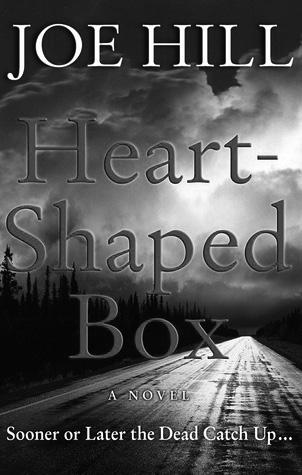
This book is the story of Judas Coyne, formerly Justin Cowzynski, who is the front man of a death metal band that never gets named.
He collects really creepy things, like a used noose, a signed witch’s confession and a snuff film. One day, his assistant Danny tells him about an auction online to buy a dead man’s suit.
Of course, it’s not just a suit; it also has the guy’s ghost with it. So Judas immediately says, “yes, let’s buy a ghost online.”
And that’s where the book lost me. It’s just such a far-fetched and plain old stupid plot concept. A death metal star bought a ghost online. I’m sorry, but even Slipknot (an Iowan treasure) wouldn’t make any headlines by doing that. Basically, the plot from there is that Judas had dated this girl Anna, who he called Florida because that’s where she was from (he was currently dating Marybeth a.k.a. Georgia), who had depression and never really talked about her past.
Judas kicked her out once she became super depressed, which is a really awful thing to do, and she went home and killed herself. So then Anna’s sister set up this
whole website thing to sell Judas their stepfather’s ghost, which Judas bought without a thought.
So now his ex-girlfriends stepfather, who was a hypnotist back in his day, is haunting him.
The ghost seems certain that he’ll make Judas kill himself, and he’s almost successful in doing so, but somehow Georgia or one of Judas’ dogs interrupts them each time.
Judas and Georgia then hit the road to go talk to Anna’s sister and figure out how to get rid of her stepfather’s ghost.
The thing that gets me though is how stupid they are throughout the whole thing. They think that they’re being smart, but they’re making stereotypical personin-horror-movie decisions.
Like, ‘Oh wow! An old mansion that’s rumored to be haunted by bloodthirsty ghosts! Looks like a fixer-upper!’ type of person. At one point, Georgia burns
the suit, as if that’s going to fix anything, and by doing so, makes sure that they can’t get rid of the ghost at all. Then Judas is like, ‘Seems like the dogs scare the ghost, so I’ll just hang out with my dogs and the ghost will never ever find out how to get past them.’ Seriously, it’s so annoying. So if this review convinced you to read this book, I’m kind of wondering what you look for in entertainment.
I will say that it is a good ending; it seems to tie up whatever loose ends it leaves throughout.
It’s well written, just a dumb concept. I would give it two out of five stars.
Emily Larson Fashion Columnist emily.larson@drake.edu @emj_larson

My mother is the biggest health guru I know. I have grown up living an “organic lifestyle”. We eat all organic foods and only use organic products (no parabens or harsh chemicals) in our household.
One of the things I have discovered throughout the years to be the most wondrous product above all is coconut oil. Coconut oil is an all-natural substance that is highly promoted by my mom. She is a stay-at-home mother who has dedicated her life to making our diets and lifestyles as healthy as possible; if she endorses a product, I know it has to be good.
If you have never heard of it, it is a white gel-like product contained in a jar you can usually find in any grocery store.
I have used coconut oil for a vast amount of things including tanning lubricant, sunscreen, hair conditioner and a cooking oil.
But upon doing more research via the internet’s widely known website, Pinterest, I discovered even more uses for this resourceful commodity.
How could it be both tanning oil and sunscreen? It attracts the right sun rays so you will retain color without inflicting the pain of a sunburn on your skin.
When I learned this information I was intrigued and tested it out. Indeed it is true; I turned a shade of brilliant bronze versus the lobster red I had come to fear.
Plus, my skin felt rejuvenated. It acted as a moisturizer that left me feeling velvety smooth. If you are not planning on lounging in the sun, but still yearn for the soft skin it can provide, feel free to use
According to Pinterest, if you add a teaspoon to your shampoo or simply rub it in your hair and then shampoo it, your hair will be as glossy as Gigi Hadid’s in the Maybelline commercials. Maybe it’s Maybelline, maybe it’s coconut oil.
Another popular use for the oil is in cooking. When sautéing meats, vegetables or eggs you can put a spoonful of coconut oil in the pan instead of an unhealthier substance like butter.
I am a big fan of the smoothie, specifically kale and spinach smoothies in the morning. Adding a tablespoon of the oil to your recipe will not only improve the taste of it but the benefits of the healthy smoothie as well.
Coconut oil assists in losing weight through its’ proper fatty acids, improves blood circulation, boosts energy and mental awareness, aids digestion and acts as a reliever for constipation.
Reading this long list of body betterments that can result in just a spoonful of this stuff, I hope you have hopped on the coconut oil train.
A jar of coconut oil is cheap and easy to store in the dorms. It does not need to be refrigerated but it can be. I keep it on the shelf right next to my peanut butter and honey.
Its’ versatile possibilities make it as necessary as a tube of mascara or a Keurig.
So, quick, run over to Walgreens and grab yourself a jar of this wondrous oil.
05 | opinions Feb. 01, 2017
MUSIC REVIEW
Klyn Music Critic parker.klyn@drake.edu @KlynParker
REVIEW
‘Heart-Shaped
BOOK
MIGOS’ new album disappoints after producing hits such as “Hannah Montana,” “Bricks” and “Bad and Boujee.” PHOTO COURTESY OF MIGOS’ TWITTER
“Heart-Shaped Box” tells the story of Judas, who buys a dead man’s suit and struggles with the ghost that comes with it. PHOTO FROM AMAZON.COM
Student optimistic about the future of elephants after ivory trade ban
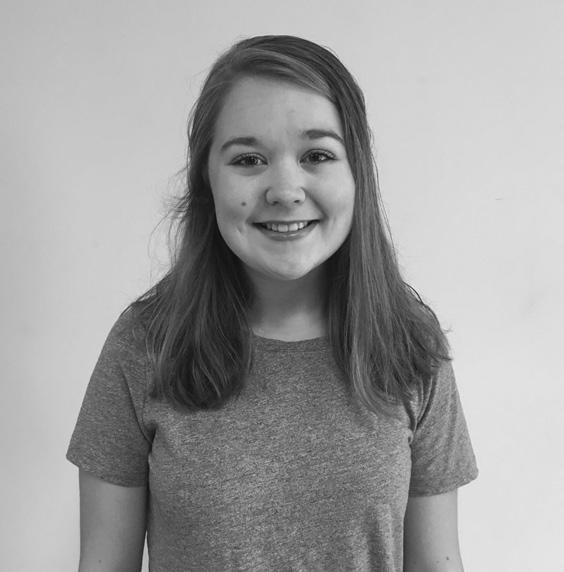

According to EleAid.com, there are approximately 250 wild elephants in China today that will benefit from this law.
Snap Partnership online tells us that around 35,000 elephants are killed a year to support the demand for ivory exchange in Asia. This trading is primarily done in China.
Their conservation status is endangered and population decreasing. Any measures that can be taken to stop them from going extinct should be taken-need to be taken.
One of the biggest problems that is toughest to stop is illegal poaching. The passing of this law will (hopefully) end it though.
African elephant ivory.
The new rules further limited exports and sales across state lines and restricted a hunter’s allowable ivory trophy imports to no more than two a year.” This was the END Wildlife Trafficking Act.

of the largest ivory markets have taken action that will reverberate around the world.”
Emily Larson Fashion Columnist emily.larson@drake.edu
@emj_larson
China has announced that by the end of 2017 they will be banning the domestic trade of ivory.
The end of ivory trading will help in the saving of the lives of the endangered elephants in China.
The selling of ivory becoming illegal is a big step towards renewing the populations of elephants. The price of ivory can reach up to $1,100 per kg; it is seen as a symbol of high status and sought after by many.
The fact that the world’s largest trading market for elephant ivory is being shut down caught my eye immediately. Elephants are something I have been passionate about for a number of years. I adore the big, gentle creatures and their endangerment is something that deeply saddens me.
The Chinese government plans to put their fist down and make it much more difficult for these poachers to hunt and sell on the black market.
The global trading of ivory was banned in 1989 but in the past few years poaching has spiked once again resulting in elephant populations dropping rapidly.
According to National Geographic, “The U.S., also a significant market for elephant ivory, held up its end of the agreement with China in June when it enacted a near-total ban on the commercial trade of
This act is meant to stop illegal ivory trade along with all illegal wildlife trafficking in the United States. If more countries like China and the United States will continue this trend of stopping wildlife trafficking and poaching, this planet’s animals are sure to be better off.
The president and chief executive of the World Wildlife Fund, Carter Roberts, was quoted in the New York Times to saying, “China’s announcement is a game changer for elephant conservation, with the United States also ending its domestic ivory trade earlier this year, two
Many wildlife advocates and experts have said for years now that the end of the huge trading hub, Hong Kong, China, specifically, will have lasting effects in saving the earth’s elephants.
This law is a beacon of hope for the precious land mammal and generations of elephants to come. I want a world where they are seen as beautiful and appreciated and not money signs for their ivory tusks.
I want to see the populations of both Asian and African elephants restored past the status of endangered and onto the status of healthy.
To donate to the saving of our elephants go to saveanimalsfacingextinction.org or worldwildlife.org.
Trump executive order on Global Gag Rule incites emotion
that this wasn’t a normal one in terms of the two major parties’ candidates: Hillary Clinton and Donald Trump.
Trump recently received an approval rating of 42 percent from Gallup, which is the lowest any president has received from this poll this early in their presidency.
There is no doubt that many have started questioning, or already have been questioning this man’s ability to run the country.
Just a few days into office and Trump is already making huge changes, and recently made one for the worse.
provide abortion services will no longer receive funding from the U.S. By reinstating the Global Gag Rule, it will cut off U.S. foreign aid for NGOs in other countries who provide abortion services or discuss abortion as an option for family planning.
Instead of targeting only family planning, Trump expanded it to include all global health services. This will hit the world’s most vulnerable women, who already struggle to find reproductive services and need more help with family planning.
Over the years abortion has been a hard and heavy topic, and one in which I’ve mulled over a great deal in the recent events of the inauguration.
I personally do not believe that Trump, an elderly man, should be making a decision that affects millions of women -- especially when he doesn’t fully understand how the woman’s body works.
Soon, many people’s lives will take a turn in a chaotic direction due to a series of new executive orders signed by President Trump. With the intense coverage of the election, it became apparent
On Monday, President Trump signed an executive bill over abortion, causing women in other countries to have less access to safe abortion methods. It has been decided that nongovernmental organizations that
Harmful methods of abortion will likely start to rise again, and we could even see the movement back towards coathanger abortions. This would be devastating, as it should be a woman’s right to choose what she does with her body.
Everyone is entitled to their own opinions, which is a great freedom of the United States. Although when it comes to the decisions of one’s body, I feel that women should have the freedom to make their own reproductive health choices and be able to have easy access to reproductive health care.
Religion has factored into this debate multiple times, but if we take religion out of politics then the decision becomes clear to me.
The right to stop an unplanned pregnancy should be left up to the woman.
By Trump denying women of this right, the overall health of women across the world who can’t access this will decline. Not only will their physical wellbeing worsen, but the toll on their mental health could be quite damaging as well.
Women in poorer countries around the world will be denied something that could potentially save their life.
The initiation of the Global Gag Rule is sad, and it truly disappoints me that our nation elected a man who will put many women’s lives in danger across the globe. Abortion should be the choice of the woman. It is her body and she should not be denied this safe procedure, especially when her life could be in danger.
06 | opinions Feb. 01, 2017
OPINIONS
DIGITAL EDITOR
35,000 ELEPHANTS according to Snap Partnership, are killed every year for their tusks. Some groups are organizing to save the elephants from trade. PHOTO COURTESY OF JAKE BULLINGTON |
ANIMAL RIGHTS
Ellie Hilscher Contributing Writer ellie.hilscher@drake.edu
WORLD ISSUES
Professor Megan Brown’s book discusses post 9/11 America
Haley Hodges Staff Writer haley.hodges@drake.edu
For most students at Drake University, memories of the events of 9/11 are faded or fabricated with details they’ve been told of the fateful day to fill in the gaps from a young memory.
Professors can offer a view of their recollection to students on the anniversary or as it becomes relevant to their studies, with some having more personal accounts that they’re willing to share.
For Megan Brown, an English professor known for teaching several courses with focuses on autobiographies, memoirs, and personal essays, the event struck, quite literally, close to home.
Brown, a native New Yorker said she was in Pennsylvania as a grad student at the time, about to teach a class of freshmen writing students, when the news started to come in.
“I wasn’t there, but I felt it very keenly,” Brown said.
From that moment on, Brown started seeing a new trend in the landscape of autobiographies and memoirs through her studies and her teaching.
She noted a kind of shift in what stories were being told that she hypothesized in her new book, “American Autobiography After 9/11.”
“I was noticing these trends and these sort of conglomerates of different books that I was looking at and I thought, you know, all of these books have this common theme of anxiety and identity and all of them were published after 9/11, is there a way to connect those two things?” Brown said.
The book, released in January, discusses the shift in focus, whether intentional or not, in a post 9/11 world.
“As we become more distant from it, I think it’s more difficult to understand the sort of explosion of anxiety that occurred in the wake of [9/11]…” Brown said. “With that in mind I thought about ... how are people coping? How are people working through their feelings? And I think one way was by reading other people’s accounts, other people’s life stories. Even if they weren’t about 9/11 per say, and a lot of them weren’t ... even if
J-TERM
they’re not dealing with 9/11 specifically, I felt they really were born out of that cultural moment and negotiating with these issues of vulnerability and anxiety and identity.”
Brown said since she started teaching at Drake she found a new interest in autobiographical topics and picked up teaching several classes focusing on the discipline.
Brown started at Drake in 2005w and picked up autobiography classes in 2006.
“... In reading a lot of memoirs with my students and in the process of planning my courses, I realized some very broad trends, particularly ones that were written by fairly contemporary American authors,” Brown said. “The trend I noticed most was that a lot of these memoir writers seemed to be struggling with and processing issues of identity and having anxieties about issues of identity.”
Brown referenced popular books such as Cheryl Strayed’s “Wild” and James Frey’s “A Million Little Pieces” that contributed to her understanding of the new kind of autobiography that dealt with issues of anxieties. She felt those stemmed from living after 9/11.
She also said one of the essays she teaches in her classes, Tom Junod’s “The Falling Man” was always part of her curriculum that she questioned pulling due to its upsetting details about 9/11, but always kept it and found that it prompted important discussions with her students.
“If it weren’t for many conversations with my students, I’m not sure the book would have happened,” Brown said. “I’m tremendously grateful to the students who were in my seminars over the years… for their insights on why they read memoir, what they think the effects of memoir are in the world. In fact, the last chapter of the book quotes from a number of my students over the years from their written work and conversations with them. I’m really glad that that’s in there and I still like when I’m writing about these things to pull in student work whenever I can.”
American Autobiography
After 9/11 is out now and will be available at Cowles Library for students to access soon.

January-Term benefits students, whether abroad or in Iowa
life,” Novack said. “It’s a really cool place and it’s really difficult to get there on your own. There’s a lot of paperwork and hoops to jump through, and it’s nice to go with a group that handles that stuff for you.”
Studying abroad has almost become a cliché of college life.
“You’ll never have the opportunity again” or “I want to see the world” are oftheard platitudes regarding the opportunity.
Not every student is able or willing to go abroad for a full semester, however. And so month-long J-Term and MayTerm courses fill the need for many of those students.
“I would rather go to three or four different places for three weeks each than go to just one place for an entire semester,” junior Josh Novack said.
In January 2016, Novack went to Rwanda in a course entitled Ecotourism and Development in Post-Genocide Rwanda. More recently, he just got back from a three-week trip to Ecuador and the Galapagos Islands with 17 other Bulldogs.
One of the common benefits of traveling during college is the lightened burden of planning, as so many courses do some, most or all of the pre-trip preparation and scheduling for the studenttraveler.
“I wanted to go to the Galapagos really badly my whole
Still, others elected to hang back in Iowa during January. Being able to focus on just one class without other school-related distractions or the heftier price tag associated with international travel, is alluring to many students.
Junior international relations major Molly Silverstein took China’s Economic History Before 1949, taught by Fulbright Scholar Yang Li, this past month.
The course counted doubly for Silverstein, as it helped cover credits for her major as well as an economics minor.
She mentioned considering a travel course, but started doing her research too late to enroll.
A J-Term to China wasn’t being offered anyways, and that’s primarily where Silverstein said she would’ve wanted to go.
“I did like my J-Term,” Silverstein said. “I guess, for me, I just didn’t really look at the abroad stuff in time.”
Drake’s 2017 J-Term program still offered 10 travel courses to eight countries (including the US) on five continents.









To learn more, log on to drake. edu/dc/j-termexperience.

FEATURES 07 | features Feb. 01, 2017
ENTERTAINMENT
MEGAN BROWN’S book focuses on identity, anxiety and coping ability in this post 9/11 America. She believes everyone is affected, whether first-hand or second-hand, by the event. PHOTO COURTESY OF MEGAN BROWN
Students who took a J-Term on campus: 1,012 Students who took a Travel Seminar outside of the US: 141 Students who took a Travel Seminar within the US: 51 J-Term courses offered offcampus, within the US and abroad: 10 J-Term courses offered on campus: 69 Statistics courtesy of J-Term Oversight Committee Chair, Professor Arthur Sanders, and the Drake International Office.
Adam Rogan Managing Editor adam.rogan@drake.edu @adam_rogan
2017 J-Term Statistics
“No Coast” play, written by Raygun owner
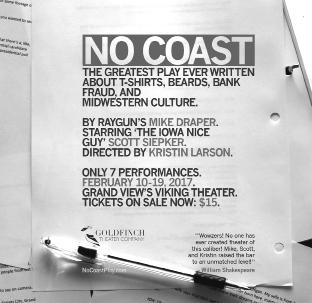 Natalie Larimer Contributing Writer natalie.larimer@drake.edu @larimerslogic
Natalie Larimer Contributing Writer natalie.larimer@drake.edu @larimerslogic

Plenty of artists can be found throughout the US, especially in big cities like Des Moines.
Local entrepreneur Mike Draper has contributed in the form of witty t-shirts, via his business Raygun. But now Draper has a new project in the works, something to contribute to the theater scene of Des Moines and the Midwest.”
“It’s the greatest play ever written about t-shirts, beards, bank fraud and Midwestern culture,” Draper said.
His first play, called “No Coast” will debut in February of this year.
While “No Coast” is based on Raygun, it’s not the history of the store.
“It’s centered about a clothing store in Des Moines, Iowa, that does its own design, so the store is similar to Raygun in that some of the content is the same,” Draper said. “It’s a re-imagining of the store and the in-between of the creative side of running a business and the business side.”
As it is a play about a clothing store, it has to have elements of running an actual business involved.
“There are graphs of income versus expense and cash flow so anyone who watches it and wonders how a business works internally, they’re going to learn something,” Draper said. “I’m obviously not going to pitch it to people saying that there’s graphs about cash flow, but it is somewhat necessary to explain
how a business can sell a lot of stuff and bring in a lot of money while also struggling with finances.”
Draper likened it to worrying about the next month’s income while also trying to come up with a funny Tweet.
Once Draper had a script, he brought it to Kristen Larson, the head of the theater department at Grand View University in Des Moines. Larson is now directing the production.
“It’s very unique to the Midwest and it’s really just very funny,” Larson said. “It’s very sweet and has a great cast, it’s just a good way for Midwesterners to enjoy a story with a lot of heart in it.”
Draper said he would like to continue playwriting as a creative outlet from time to time.
“It depends on how this turns out,” Draper said. “If this ends up being a total dumpster fire then I’m not sure it’ll motivate anyone in wanting to be in another theater endeavor with me. There’s no money in it so I’m not going to like, quit my day job and just do this.”
Draper wrote the whole script in a couple hours after thinking about it for a long time while sleep-training his youngest son.
When it got to Larson, it was a huge script that needed to be shaped into a polished form.
The two met via a common acquaintance, Scott Siepker, who is playing the lead role im “No Coast.”
Larson and Siepker own Goldfinch Theater together and have been working with each other for a couple years now, but this experience with Draper still
STUDENT LIFE Humans of Drake
felt new and revitalizing.
“It’s so easy and it’s fun and not burdened by a lot of drama or ego,” Larson said.
“No Coast” is about Iowa in that it gives a critical viewpoint through the eyes of a local business in Des Moines.
“It kind of takes the way that people think about Iowa and turns it on its head,” Larson said. “You get the view of a native Iowan who pokes fun at their own state. You’re going to have fun and it’s going to be a delightful experience.”
The play takes some elements of satire, but is not classified specifically as a satirical play.
“You could call it comedy. It doesn’t end in somebody dying so it’s not a tragedy,” Draper said. “It keeps the humor throughout and it kind of keeps human emotion at an arms length which. I was born without feelings, so that’s where I keep human emotions anyway.”
It does not have the kind of slap-stick comedy that common in local theater, meaning that this could shape the scene of Midwestern-based plays.
“In the middle of winter it is nice to get into a room with other Midwesterners and have a good laugh and hear a good story,” Larson said.
Tickets are $15 each and the show will run from Feb. 10 through 17 at the Grand View Viking Theater.
“I think it will be slightly above people’s expectations as long as their expectations are moderate,” Draper said.
The Times-Delphic tells the stories of Drake students and faculty
Maddi Cheek Sophomore Anthropology and Sociology
Relays Brainstorming
The Times-Delphic’s biggest issue, the 40-page full color Relays Edition, is right around the corner. Come work with the editorial staff to plan out and work on the edition at the Brainstorming Meeting on Feb. 23 at 7 p.m.
Drake student shares stories of Drake Neighborhood memeber through podcast
Haley Hodges Staff Writer haley.hodges@drake.edu
When sophomore Madeline Cheek’s J-Term class in Mexico was canceled, she signed up for the “Humans of the Drake Neighborhood” class instead.
“I wanted to take this class because we were going to do a project that we had a lot of liberty in,” Cheek said, and added that it counted toward her anthropology and sociology majors.
While the name of the class may have been inspired by Brandon Stanton’s “Humans of New York” project, it aimed to capture people’s stories in a way that was different from most branch-off projects.
Stanton’s “Humans of New York,” and, subsequently, “Humans of Drake,” involves a photo and provides a story. But for the Humans of the Drake Neighborhood, Cheek said her professor, Darcie Vandegrift, took to a new medium.
“The medium we used to comment on the community studies that we did in the class were podcasts,” Cheek said. “So we listened to some podcasts, we did a trial podcast on a member of the class and then we did a big podcast project at the end.”
“I learned that this whole underground world of podcasts exists,” Cheek said. “... It’s a great way of telling stories. We talked about it in class as a type of horizontal power because anyone can create a podcast, anyone can listen to a podcast and anybody can be part of a podcast. All you need is a cell phone, so that’s really cool.”
For the final project, Cheek interviewed and did her podcast
on Lisa Grulke, a lab assistant at Drake, who lives in the area.
“My partner had a connection with (Grulke), she had her for lab,” Cheek said. “(Grulke) has this reputation for being this incredibly kind and open person and a bunch of people who go to Drake know her. Our podcast is called ‘Lisa’s House’ because she invited us over to her home for the interview… and she opens her home to so many different people and students.”
Cheek said that Gruike made them Norweigan waffles and coffee. She had a tea party spread with cheeses and fruits.
She learned that “the most important part of storytelling is listening.”
Cheek said that she has been a fan of “Humans of New York,” but was interested by this new take for her class and how it could be localized to the community around Drake.
“We talked about how communities are made up of regular people and the best way to understand the community is to get into it and experience it and talk to people and find out what their experiences and needs are,” Cheek said. “The most important thing when getting involved in a community is that there are a lot of diverse needs in a community. If you only cater to one audience, your community is going to become static and ultimately fail, so the best way to keep the vibrant community is to remember and address diversity.”
Cheek and her classmates’ podcasts are available through the Cowles Library archives.
FEATURES 08 | features Feb. 01, 2017
ENTERTAINMENT
PHOTO COURTESY
“NO COAST” hopes to redefine Midwestern theater productions. Draper’s play is satirical in a unique way and he hopes Iowans will appreciate his take on a humoring story
.
OF MIKE DRAPER
in Meredith Hall
Through minimalist movement, mom gives children the world
up with other families through a website called “Full Time Family.”


















































































































































“Our first stop was along the East Coast and I would look out and see 157 kids running around outside on the campsite,” Logue said.
Imagine life on the road—one day in Florida on the beach, the next in Georgia on a balcony overlooking a peach tree while eating peach pie. Finally, traveling to New York, marveling in the evening glow of Times Square.
Recently, single mom, Sara Logue had the same thoughts. Soon her house was up on the market. After multiple garage sales, donations to the Salvation Army, a ton of research and an RV later, her and her two sons were on the road.
Through her research, she found an online school that worked with the K-12 public schools in Des Moines and realized that many families with children are out on the road and learning by what Logue called “education by immersion.”
“Around 1,500 families are out doing this,” Logue said.
Along the way she has met
CAMPUS LIFE
Her two sons, six-year-old Tristan and three-year-old Jasper are taking classes through Iowa Virtual Academy.
The online school is tuition free, and has real teachers that call in via Skype. Logue says the
best part is that the boys lessons are synced up to their travel schedule.
“When we were in Niagara Falls, the boys were learning about nature and climate,” Logue said. “When we were in Vermont, they were learning hands on how to make maple syrup, and when we were in Washington we got to tour the White House while the boys were learning about the government system.”
Logue has found her boys being much more engaged with the material they are learning since they have been on the road. She believes children learn best in interactive situations as opposed to the classroom.
The boys are learning so much more about the world than they would be learning in Iowa, Logue said. They are biking and hiking, using maps to understand the geography of the US and many activities that aren’t taught in a normal classroom.
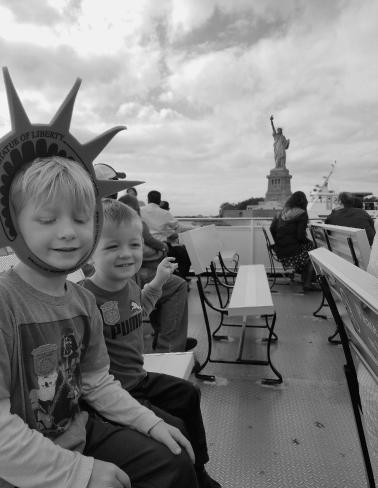
The family’s excursion ends in August after a little over a year on the road. Logue is nervous to reenter her boys into the structured
school environment after such an interactive education.
“Academically, the K-12 academy has absolutely prepared (my sons) to jump back into public schooling. I don’t think that will be the problem,” Logue said. “The hardest thing will be the structure because I don’t think it is as conducive to kinetic, hands-on learners. But I am not trying to shelter them from reality.”
Beyond her sons’ education, the trip has helped Logue become more confident in her mothering skills and more laid back in her personal and professional life.
“I have learned to handle life better,” Logue said. “I’m less stressed out because this trip has helped me realize what’s really important, and that’s spending time with my kids.”
Before the trip, Logue had recently gone through a divorce that came as a bit of a shock.
“It made me question if I was being a good mom,” Logue said. “I was checking all the boxes … We had our first beautiful new home and I felt like I was giving
everything I had and then life blew up in my face.”
Logue wanted to do something that would help her find herself again and prioritize what mattered, while also giving her sons the unique opportunity to learn unconventionally. She quickly realized that this trip would check all her new boxes; it was her year’s purpose.
“Before the trip I was spending my weekends shopping and stockpiling items from Costco, and I just wasn’t finding any of it fulfilling,” Logue said. “Right now, we’re in the midst of a minimalist movement. I don’t want or need all the stuff I had before. I want a small house when we come home.”
The family has been to Florida, Arizona, California and is now headed east to finish up their yearlong RV trip around the US Logue hopes to do a similar trip in the future, when the boys finish their high school years.

“Above all, the greatest gift I could give my sons is a love of learning,” Logue said.
Bulldogs’ Papercut use: How much we printed, what it means










According to Papercut’s Environmental Dashboard, Drake students accounted for the following from April 14, 2016-Dec. 25, 2016 through printing via Papercut...







































...used 119,514,240 watts of power. That’s long enough to keep one 60-watt lightbulb lit from Nov. 7, 1789 until today. At that time, the US still only had 13 states, Benjamin Franklin was alive and neither the bicycle, nor the train had been invented.


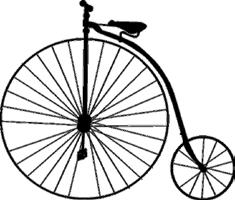
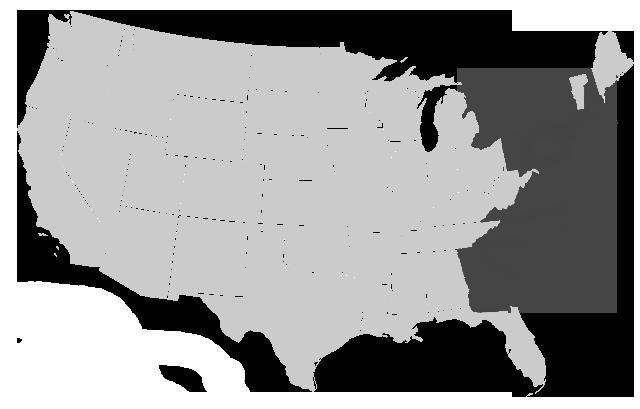
FEATURES 09 | features Feb. 01, 2017
31,814 kilograms of CO2, the equivalent of 1,010 English Bulldogs or 510,008 basketballs. ...used up 300.6 trees. Each basketball represents 220.9 kilograms. Each bulldog represents 100 kilograms. The CO2 produced is the result of the greenhouse gases released in converting the paper from trees. Each tree pictured represents 7.7 trees. 1789 2017 TRAVEL
...produced
Anna Jensen Features Editor anna.jensen@drake.edu @annaxjensen
“Right now, we are in the midst of a minimalist movement. I don’t want or need all the stuff I had before. I want a small house when we come home.”
Sara Logue Single Mom
FROM LEFT TO RIGHT, sons Tristan, 6, and Jasper, 3, outside of their camper in Camp Eriez, Erie, PA. The camper has a separate master bedroom, kitchen and dining, living room area, bathroom and separate bunk room for the boys that can sleep six kids comfortably. The boys are also pictured in New York riding the Liberty Ferry after seeing the Statue of Liberty. PHOTOS COURTESY OF SARA LOGUE
Information gathered by Adam Rogan | Managing Editor
CROSS-COUNTRY COLUMN
T&F is back for 2017

Your Drake Track and Field Men and Women’s Teams are back in action this semester, having reached the halfway point in their season with multiple PR’s and top five finishes at meets. The season began with our first meet at Central College in Pella, Iowa, in December before winter break. We are now four meets into the eight-meet season, and the second half of our racing schedule will be used to gear up for the Missouri Valley Conference Indoor Championship meet at the end of February.
This past weekend the team travelled to the University of Northern Iowa to compete against two MVC teams, Indiana State and UNI, as well as South Dakota State University and University if Wisconsin- Milwaukee. Drake recorded three first-place finishes with Mary Young in the 60m hurdles and 200m dash and Bas Van Leersum in the 400m dash.
Since UNI is the only MVC facility that has an indoor track that meets competition regulation standards, the MVC Indoor Championships are held there each year. This past weekend’s meet at UNI was a great chance for DTF (Drake Track and Field) athletes to compete on the same track, ring or pit that they will face at Conference. UNI’s track is a 200-meter track with no banked edges, so it is good for our sprint and mid-distance athletes to get a feel for getting around those tight turns at full speed.
In addition to experiencing the facilities we will use at the Conference meet, this mid-season UNI meet was a chance to face some MVC competitors before the Indoor Championships.
Indiana State and UNI are both MVC universities that Drake athletes will compete against in one month’s time, and this past weekend was an important showdown between the three MVC schools. For the Drake freshmen, it was an opportunity to pick up on the tactics of their MVC competitors and then work on developing a competition strategy for Conference. For the upperclassmen, the meet served the same purpose and also served to show Drake athletes where they are doing well and what areas of their event need some fine-tuning before the Championships.
After this weekend, Drake Track and Field will have three more opportunities to compete before the MVC showdown. Each chance to compete is a chance to improve PRs, gain confidence and win events before doing so at the MVC Championships.
We aspire to get better each meet, and after each meet we will share one athlete’s new best mark. This week’s featured PR: Meghan Kearney, Mile Run, 5:16.92 (previous PR: 5:26.87).
#GetAnotherOne
Bailee Cofer Columnist bailee.cofer@drake.edu

Former assistant coach claims she was fired because of her sexuality
Adam Rogan Managing Editor adam.rogan@drake.edu @adam_rogan
A former Drake Women’s Basketball assistant coach, Courtney Graham, has filed a civil rights lawsuit against Drake University, claiming she was forced to resign from her post due to her sexual orientation.
On Dec. 23, Graham’s lawyer filed a federal court complaint against Drake University and Women’s Basketball head coach Jennie Barancyzk.
Graham worked as a coach for Drake Women’s Basketball from May 2012 until she was asked to resign in May 2015. She made “numerous attempts to stay on her job” before officially resigning on June 5, 2015, according to the court filing.
The court filing claims that Graham was discriminated against by having her responsibilities stripped and being sent home without explanation. The alleged discrimination began after her sexuality became known in November 2014 when Graham’s girlfriend, to whom she is now married, attended a game at the Knapp Center.
The filing also said that, after finding out about Graham’s sexuality, Barancyzk told fellow staff members that Graham had been diagnosed with ADHD and was receiving therapy.
Barancyzk has been Drake Women’s Basketball’s head coach since the 2012-13 season. Since then, the team has posted four consecutive winning seasons with two WNIT postseason appearances.
This is the second civil rights case filed against the university in less than two months, both coming from former Drake Athletics staff
members. In November, former Head Athletic Trainer Scott Kerr sued the school after being fired two months earlier, believing he was let go unlawfully because of a medical condition.
In a statement, Drake University said that it “denies the claims and allegations made by former assistant women’s basketball coach Courtney Graham.” The statement went on to say that “Drake University and head women’s basketball coach Jennie Baranczyk have a strong commitment to diversity, tolerance, and nondiscrimination.”
Drake’s statement claims that the Iowa Civil Rights Commission “found the facts and information did not support a reasonable possibility that further investigation would reveal discrimination occurred.”
However, the Equal Employment Opportunity Commission (EEOC) still issued a “Right to Sue” letter on Graham’s behalf on Oct. 28.
In an email, an Iowa Civil Rights Commission spokeswoman told The TimesDelphic that Graham is allowed to pursue a civil case so long as an administrative judge had not issued a “no probable cause order,” which has apparently not occurred in this case. The specifics of Graham’s Iowa Civil Rights Commission case are confidential.
The court filing requested a trial by jury to settle the case. This lawsuit marks a continuation of uncertainty for the athletics department. In addition to the lawsuit from Kerr, Ray Giacoletti, the men’s basketball coach, resigned in the middle of the season.
SPORTS 10 | sports Feb. 01, 2017
Mark Messersmith Track & Field Invitational Cedar Falls, Iowa || 01/28/2017 Team Rankings – Through Event 30
1. Indiana State 174 2. Northern Iowa 87 3. Wis.-Milwaukee 63 4. Drake 53 5. South Dakota St. 52 Male Team Scores 1. Indiana State 153 2. Northern Iowa 115 3. South Dakota St. 84 4. Wis.-Milwaukee 47 5. Drake 30
Female Team Scores
BASKETBALL
WOMEN’S
of
Second lawsuit
academic year
Bulldogs living up to preseason expectations. Can they win thechampionship?
The Drake women’s basketball team has remained hot through the winter months, winning 12 of the last 13 games and posting a 10game winning streak stretching all the way back to late December.
The hot streak has extended into conference play, as the Bulldogs remain at the top of the Missouri Valley Conference with a 9-0 conference record.
Drake began the hot streak with a major win against in-state rival the Iowa Hawkeyes on Dec. 18. The 81-76 win broke a 14game losing streak against the Hawkeye squad that dated back to 2001.
Four different Bulldog players — Caitlin Ingle, Lizzy Wendell, Becca Jonas and Becca Hinter — finished in double-digits, setting the tone offensively heading into conference play.
After the upset win against Iowa, the Bulldogs headed down to New Orleans, Louisiana to face off against top-rated talent in the Tulane Classic.
Drake’s first game found them pitted against Auburn, a talented SEC program. A hard-fought battle ended in an 85-80 loss for the Drake squad. Despite the loss, the Bulldogs still shot an impressive 53 percent from the floor and Senior Lizzy Wendell turned in her 53rd career 20-point performance.
Drake finished out the Tulane Classic taking on Eastern Washington, defeating the Eagles in a 93-78 rout, and somehow improved upon their impressive shooting performance earlier in the tournament by converting on 56.3 percent of their chances from the floor.
Sophomore Becca Jonas led the offensive charge in that game for the Bulldogs, finishing with 24 points.

After returning from their trip down south, the Bulldogs found themselves up against typical conference powerhouse Wichita State.
Led by a 32-point effort from Lizzy Wendell, the Bulldogs took care of the Shockers 8378. Another 53 percent shooting performance for Drake kept up the consistently dominant
offensive performance and led the Bulldogs to their first conference win.
The challenging stretch did not let up for Drake. Two days after defeating the Shockers, the Bulldogs headed to Springfield to take on the Missouri State Bears, who are currently ranked 3rd in the MVC.
Five double-digit performers brought the Bulldogs to an easy 26-point victory.
Lizzy Wendell had 22, Becca Hinter had 18, Becca Jonas had 12, Nicole Miller had 11 and Sammie Bachrodt added 10, lighting up the stat-sheet and giving Drake the 90-64 win.
After the dominating performance against the Bears, Drake’s schedule began to ease slightly as they faced off against some lower-ranked competition in the Missouri Valley.
Drake faced Evansville in their MVC home opener and took down the Purple Aces by 17 points thanks to 32 points provided by the Bulldog bench.
After falling behind early, Drake’s outstanding depth helped them rally late and coasted to an easy 82-65 victory.
Drake’s home stand continued against Southern Illinois University.

Drake’s height and strength advantage proved essential in attaining their third straight conference win, as the Bulldogs outscored SIU by 30 points in the paint.
Lizzy Wendell added another stellar scoring performance for the Bulldogs with 24 points, which helped secure the 75-59 win.
Drake’s next three games were a testament to the domination that has been going on all season.
Drake outscored their next three opponents — Bradley University, Illinois State, Loyola — by a combined score of 269-142.
Lizzy Wendell averaged 22 points in the three games. Even more impressive was the blistering shooting percentages the Bulldog’s racked up: a combined 54 percent.
As Drake matched up against the Indiana State Sycamores, the scoring slowed but the winning did not.
Despite falling behind during the second half, Drake’s staunch defense in the fourth quarter held
the Sycamores to only five points in the final frame and ultimately sealed the win for the Bulldogs.
In addition to the win, Senior Caitlin Ingle notched nine assists that brought her to the top of the all-time assist leaders in the Missouri Valley Conference with 687.
Drake’s 8-0 record was put to the test against the Northern Iowa Panthers, also 8-0 at the time.
The battle for the top spot in the Missouri Valley Conference was everything it was hyped up to be and required two overtime periods before it was finally resolved.
Knotted up at 59 at the end of the fourth quarter, both teams’ stubborn defense kept the scoring to 13 apiece in the first overtime period.
Drake ultimately closed out the second overtime period on a 6-0 run, clinching the game 88-79.
Free throws were a main source of scoring revenue for the Drake squad, as they hit 34 of 36 from the charity stripe.
Drake continues its road trip for rematches against Southern Illinois on Feb. 3 and Evansville on the Feb. 5. Catch Drake back in action Feb. 10 at the Knapp Center against Illinois State.
SPORTS 11 | sports Feb. 01, 2017
22.3 points
SENIOR LIZZY WENDELL (top) goes for a lay-up under strong defense during an exhibition game against MidAmerica Nazarene. Wendell has averaged
per
game this season with a .528 shooting percentage. (Right) Senior guard Caitlin Ingle dribbles the ball during an offensive possession. Ingle has averaged 8.1 assists this season.
1. Drake 9-0 2. Northern Iowa 8-1 3. Missouri State 6-3 4. Wichita St. 5-4 5. Southern Illinois 4-5 6. Indiana State 4-5 7. Evansville 3-6 8. Bradley 3-6 9. Illinois State 2-7 10. Loyola 1-8 How the rest of the MVC is doing: WOMEN’S BASKETBALL Drake dominates with good scoring, undeafted in MVC TONIGHT Men’s Basketball vs. Wichita State 6 p.m FEB. 4 Women’s Tennis vs. University of South Dakota 1 p.m FEB. 7 Men’s Basketball vs.Illinois State 7 p.m Coming Up at Drake FEB. 10 Women’s Basketball vs. Illinois State 7 p.m FEB. 12 Men’s Tennis vs. Middle Tennessee 9 a.m. FEB. 12 Men’s Tennis vs. University of Nebraska Omaha 4 p.m. FEB. 12 Women’s Basketball vs. Bradley 2 p.m FEB. 18 Men’s Basketball vs. Missouri State 7 p.m Joseph Miller Staff Writer joseph.w.miller@drake.edu @josephmiller3
PHOTO BY KATE KURKA | STAFF PHOTOGRAPHER
MEN’S BASKETBALL
Drake’s winning streak at home ends with loss to UNI
“What (Drake Men’s Basketball has) been able to do in getting it turned around in the last month is a tremendous story. If you watched these guys play in November and December … and now you watch the way they’ve played in the last month, that turnaround is one of the better stories, I think, in college basketball this year.”
That’s what University of Northern Iowa (10-11, 5-5 MVC) head coach Ben Jacobson said of Drake Men’s Basketball after his Panthers defeated the Bulldogs 71-63 in the Knapp Center on Saturday.
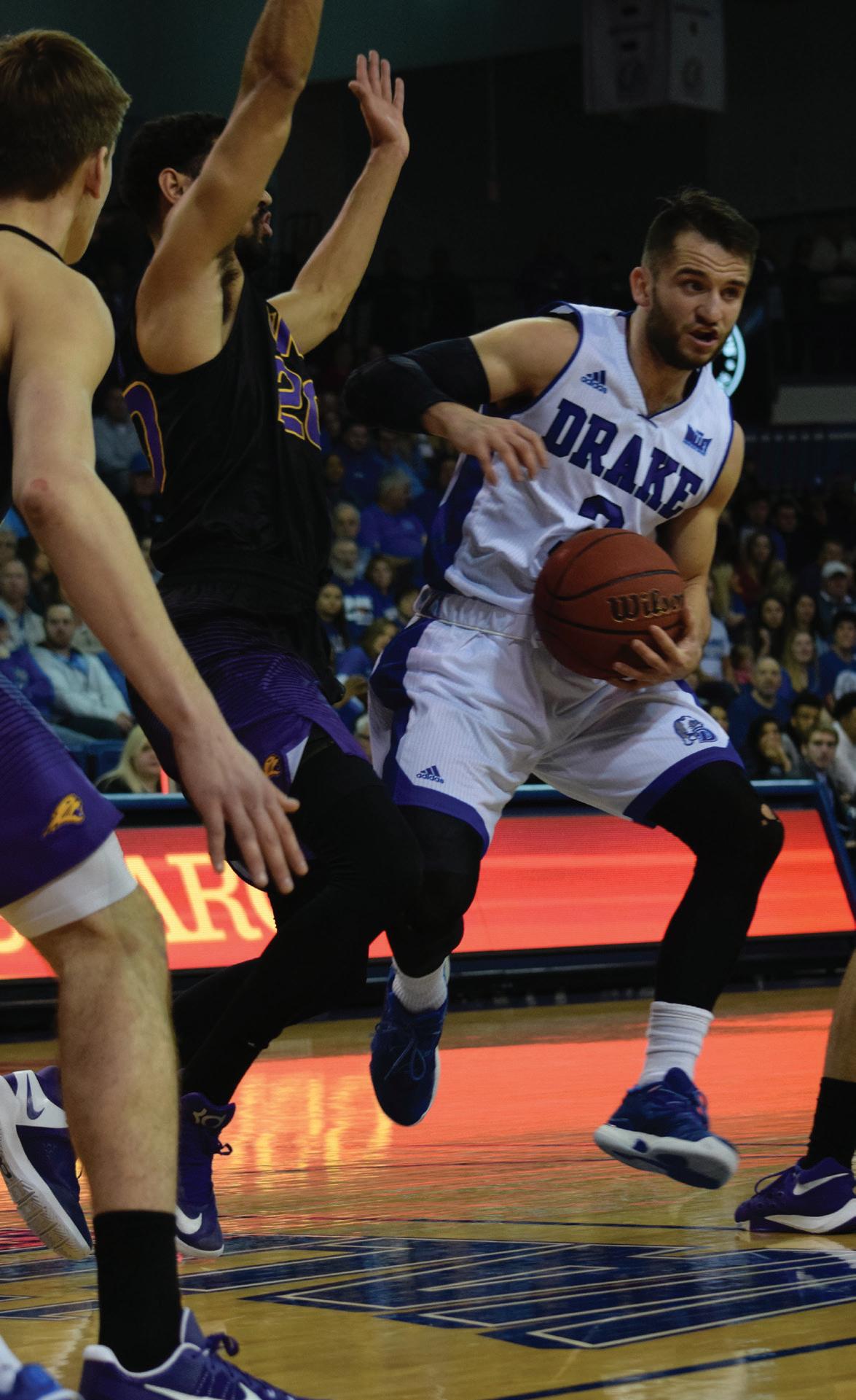
The loss snapped a five-game home win streak for DU, the program’s longest since 2011. Drake fell to 7-15, 5-5 MVC, but there were still positive takeaways from the game.
After all, the Bulldogs had played on par with UNI, the team that lost a doubledovertime thriller to Texas A&M in the second round of the NCAA Tournament last year; the team that was predicted to finish third in the Missouri Valley Conference while Drake was picked to finish dead last.
Their records are now even in the MVC, something few would’ve predicted entering the season.
Since a dismal 1-10 start to 2016-17, Drake went on to win 6 of their last 10 entering the UNI game. Perhaps the biggest change in Drake Men’s Basketball this year is the team’s spirit.
They joke on the benches. They try alley-oops and windmill dunks in warm-ups. They have fun, something that seemed lacking from the 2015-16 Drake men’s basketball squad.
Even after Saturday’s loss, Drake head coach Jeff Rutter still wore a smile on his face entering the postgame press conference. He found the positives to talk about, although he was still able to acknowledge his team’s struggles and weaknesses. His outlook is realistic in its optimism.
“As the team’s confidence has grown, it’s been so fun to watch them make plays out there on the floor,” Rutter said. “We’re kind of in our own little bubble … just trying to get better, enjoy the experience, enjoy the journey, just to be us.”
The Bulldogs only had seven wins in 2015-16. They’ve already matched that mark this season. An upward trajectory is evident.
The Game
Despite the Bulldogs’ momentum from an overtime win at Missouri State four days earlier, UNI looked like the superior team
out of the gate. As Drake settled for threes and missed the first six, the Panthers started 6-for9, sinking contested layups and runners to take an early 14-2 lead.
“We didn’t come out with that sense of urgency we needed to have,” junior forward Ore Arogundade said.
After Drake scored six unanswered eight minutes into the first half, trimming UNI’s lead from 12 to six, the Drake student section sounded like it could’ve been the final minutes of the NCAA Tournament, and it stayed that way the final minutes.
Saturday’s game showed another potential change for Drake Basketball: a substantive fan presence.
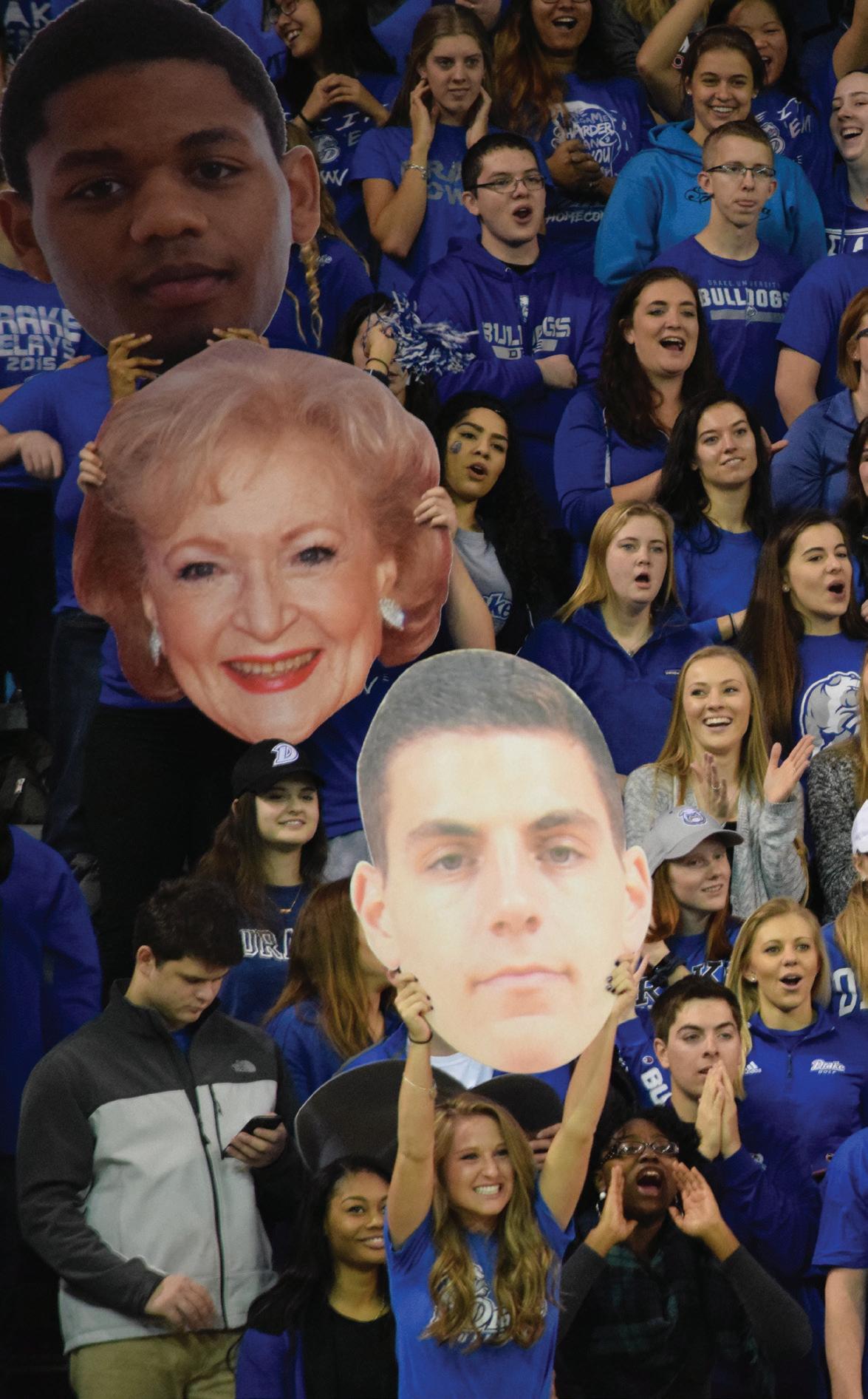
With 5,237 in attendance — the most since January 2014 — the stands neared capacity, unheard words in the Knapp Center as of late. The turnout was bolstered by the Panther faithful, with plenty of purple speckled amongst the Drake blue in the bleachers, but Bulldog fans vastly outnumbered their rivals, thanks in part to promotions like additional Facebook advertising and a Greek life event.
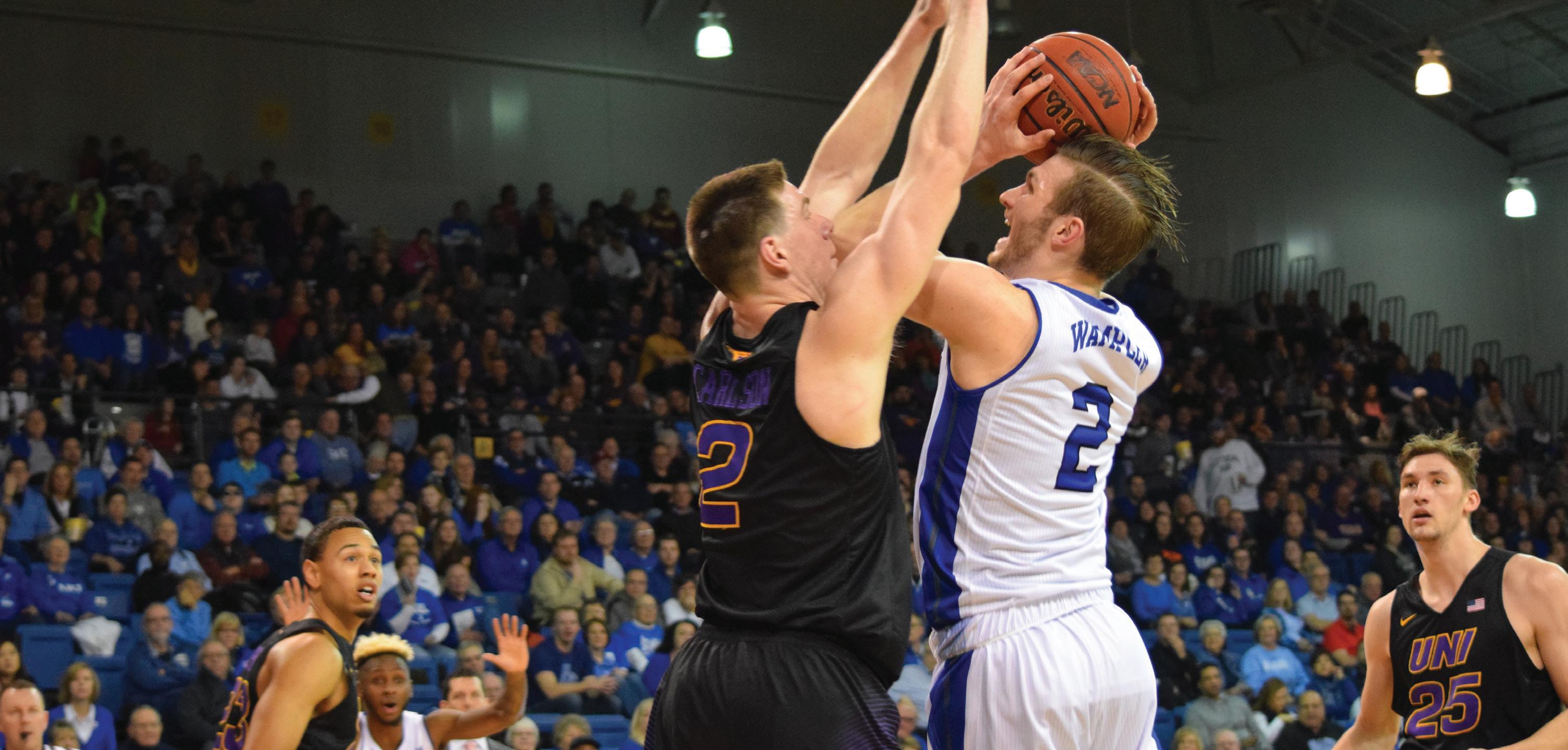
Still, scoring remained the Bulldogs’ enemy throughout the first half. They started 3-13 from the field and 0-6 from beyond the arc.
UNI wasn’t shooting much better at 1-10 from three and 42 percent from the field in the first 20 minutes, helping keep the game close. Drake finished the half shooting only 30 percent overall.
Regardless of the struggles, the Bulldogs remained committed to their long-range game. They improved in the second half, 5-16, but still closed with a threepoint percentage of just over 20 percent.
Rutter felt his team was appropriately aggressive, but was perhaps a little too eager in taking shots from downtown instead of patiently working for open looks.
“We want to be on the attack. We want our opponent to be on their heels,” Rutter said.
The Bulldogs’ bad shooting was partially forgiven by a productive defense. They forced nine first half turnovers and only gave the ball away five times. UNI was only up three at halftime.
Early in the second half, the Bulldogs showed signs of being able to upset the Panthers, rather than just keep the game competitive.
Junior De’Antae McMurray drained Drake’s first three of the second half to tie the game 31-31, the first tie of the game.
Crowd noise level: deafening.
“It definitely meant a lot to us; a lot of energy in the place,” junior guard C.J. Rivers said.
It got even louder a minute later when Enevold slipped a pass to River under the basket for an easy lay-in that gave Drake a 3331 lead, its first of the game.
After committing a shooting foul two UNI possessions later, Rivers doubled down with a technical, giving UNI senior Jeremy Morgan four free throws, of which he made three, and allowing the Panthers to retain possession.
Rivers made up for it moments later by grabbing a rebound that resulted in a Casey Schlatter layup to get Drake back on top 35-34.
Over the course of four minutes the lead would change hands six times as the studentathletes traded baskets.
Foul trouble, sparked by Rivers’ technical, allowed UNI to pull ahead. Drake put UNI into the bonus with more than 14 minutes remaining. The Panthers didn’t commit their sixth foul until there was only 6:34 left on the clock.
The Panthers took advantage, scoring 18 points from the line in the half. Drake was only 7-10 from the charity stripe in the final 20 minutes.
With 6:52 remaining, Northern Iowa was up 51-42 thanks to eight consecutive Bulldog possessions resulting in zero points. A McGlynn tip-in and Arogundade three closed the gap to four, but that was the closest Drake would get.
The Panthers scored seven straight to extend the lead to 11 with less than four minute to play. They held Drake at bay down the stretch to seal the victory.
Poor shooting throughout doomed the Bulldogs. As a team that lives (and dies) by the three — averaging 24.8 three-point attempts per game — finished 6-29 from beyond the arc. Overall shooting wasn’t much better: 38.5 percent.
UNI didn’t shoot incredibly well, finishing at a respectable 47.9 percent from the field, but it was good enough to sink the Bulldogs.
Arogundade, after not scoring in the first half, led the Bulldogs with 15 points. He and Schlatter, who finished with eight points in 14 minutes, were the only Bulldogs to shoot above 50 percent on the day.
Up Next Drake is set to host the Wichita State Shockers tonight in the Knapp Center. Wichita State is ranked no. 2 in the MVC, has an 19-4 record and was picked to win the conference this season.
If the Bulldogs can pull off the upset, it would only add to the turnaround story this season has been becoming.
“The fan
was off the charts, something we haven’t
SPORTS 12 | sports Feb. 01, 2017
SOPHOMORE BILLY WAMPLER (top) going up against tough UNI defense in last Saturday’s game. Wampler has averaged 10.5 points per game this season. (Below) Drake fans cheer while holding cutouts of celebrities and players. (Bottom) Junior Graham Woodard works through the paint. Woodard contributed 7 points against UNI. PHOTOS BY JESSICA LYNK| EDITOR-IN-CHIEF
support
seen a lot of.”
Adam Rogan Managing Editor adam.rogan@drake.edu @adam_rogan























 Natalie Larimer Contributing Writer natalie.larimer@drake.edu @larimerslogic
Natalie Larimer Contributing Writer natalie.larimer@drake.edu @larimerslogic



















